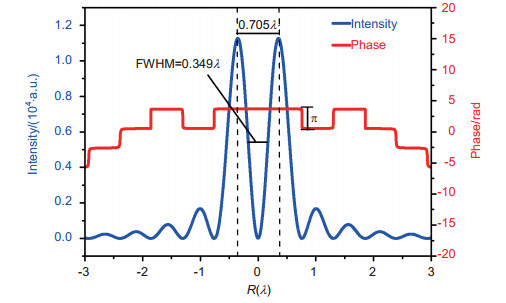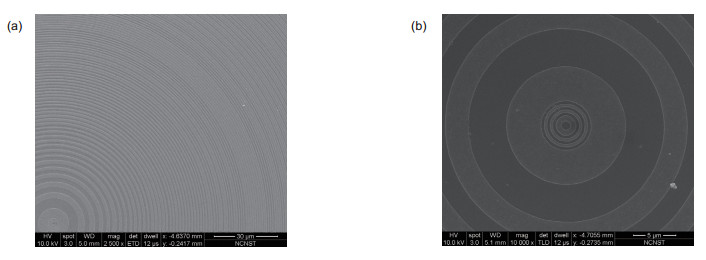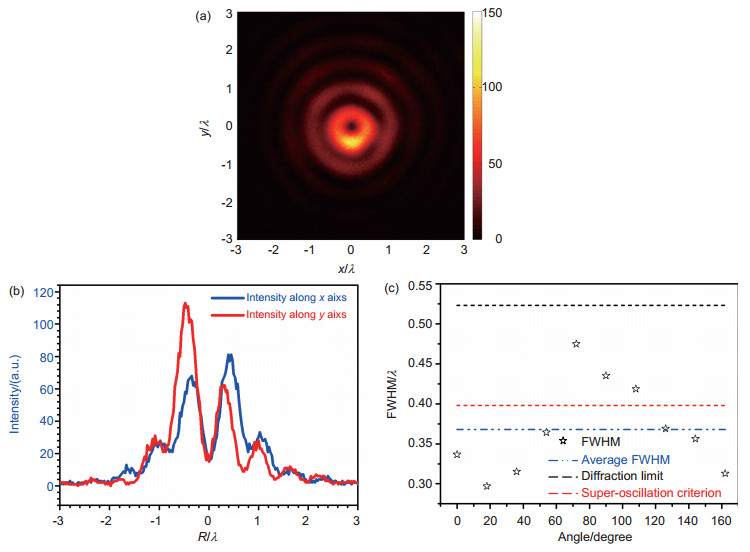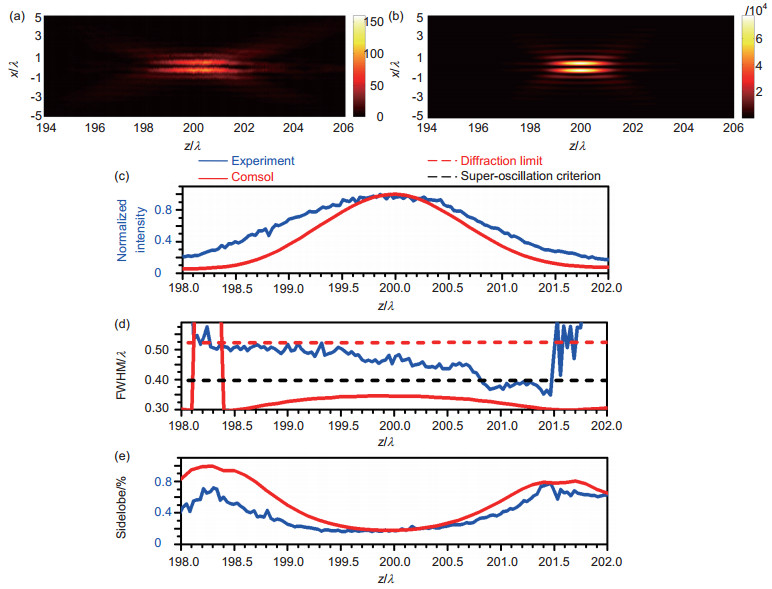Binary-amplitude modulation based super-oscillatory focusing planar lens for azimuthally polarized wave
-
摘要
角向偏振聚焦光场在超分辨光学显微、粒子操控等领域有着重要的应用。为克服传统透镜体积大、不利于集成等不足,本文提出了一种基于二值振幅(0,1)调控的角向偏振光超振荡聚焦平面透镜。针对波长λ=632.8 nm,设计、制备了超振荡平面透镜样品。透镜半径为650λ,焦距为200λ,数值孔径NA=0.96。实验结果表明:聚焦光场在焦平面上形成的空心聚焦光场呈圆环结构;空心环内径半高全宽为0.368λ,小于超振荡判据(0.38λ/NA=0.398λ);最大旁瓣比为36.7%。该平面透镜具有结构尺寸小、厚度薄、便于加工等优点,可用于光学系统的微型化和集成化。

Abstract
Tight focus of azimuthally polarized wave finds its applications in optical super-resolution, particle trapping and so on. To overcome the disadvantages of conventional optics, including bulky size and difficult for integration, a binary-amplitude (0, 1) super-oscillatory planar lens is designed for sub-diffraction focusing of azimuthally polarized wave at wavelength of 632.8 nm. The lens radius is 650λ, and its focal length is 200λ. The corresponding numerical aperture is 0.96. The experimental results demonstrate the generation of a hollow spot with circular ring shape on the focal plane. The inner full-width-at-half-maximum of the hollow spot is 0.368λ, smaller than the super-oscillatory criterion (0.398λ), and the maximum sidelobe ratio is about 36.7%. Such planar lenses are easy to fabricate. Their small size and ultra-thin thickness make them promising in system minimization and integration for different applications, such as optical microscopy, optical trapping and ultra-high density data storage.
-
Key words:
- super-oscillatory focusing /
- planar lens /
- azimuthally polarized wave /
- dark spot
-
Overview

Overview: Overview: The generation of optical dark spots is attractive for various applications, such as optical microscopy, optical tweezers and nanolithography. Due to its unique focusing properties, azimuthally polarized wave is used to generate tight focused dark spot with conventional optics. However, high numerical optical lenses are bulky and expensive, and more importantly, the conventional optics are diffraction-limited. In recent years, there has been growing interest in developing planar lenses with small size, thin thickness and light weight. To further reduce the focusing spot size, the idea of super-oscillation was proposed to overcome this restriction. In addition, super-oscillation optical fields consist of only propagating waves and can generate sub-diffraction optical features in far field. Although, super-oscillatory dark spot has been demonstrated by focusing azimuthally polarized wave with a binary-phase (0, π) lens, it requires comparatively high precision in the growth of the dielectric layer with proper thickness to ensure the correct phase delay. In this paper, a binary-amplitude (0, 1) super-oscillatory planar lens is proposed for the focusing of azimuthally polarized wave and generation of optical dark spots with super-oscillatory size. Utilizing vectoral-angular-spectrum method and particle-swarm algorithms, a planar lens was designed with a radius of 650λ and focal length of 200λ for azimuthally polarized wave at wavelength of 632.8 nm. The corresponding numerical aperture is 0.96. In the experiment, a test system based on high-numerical-aperture microscope was used to obtain the 2-dimentinal optical intensity distribution. With a nano-positioner, the objective lens can scan the 2-dimentinal optical intensity distribution at different position along the optical axis. The experimental results demonstrate the generation of a hollow spot with circular ring shape on the focal plane. The inner full-width-at-half-maximum of the hollow spot is 0.368λ, smaller than the super-oscillatory criterion (0.398λ), and the maximum sidelobe ratio is about 36.7%. Such planar lenses are easy to fabricate. Their small size and ultra-thin thickness make them promising in system minimization and integration for different applications, such as optical microscopy, optical trapping and ultra-high density data storage.
-

-
图 3 Comsol Multiphysics数值仿真结果。(a)焦平面上的光场强度分布图;(b)焦平面上光场强度沿径向的分布曲线;(c)空心聚焦光场的峰值强度(红)、内径半高全宽(蓝)和旁瓣比(绿)沿光轴的分布,其中红色虚线和黑色虚线分别表示衍射极限(0.5λ/NA)和超振荡判据(0.38λ/NA)
Figure 3. The simulation results obtained with Comsol Multiphysics. (a) The optical intensity distribution on the focal plane; (b) The optical intensity distribution along the radial coordinate on the focal plane; (c) The peak intensity (red), full-width-at-half-maximum (blue) and sidelobe ratio (green) distribution along the optical axis, where the red-dotted line and the black-dotted line represent the diffraction-limit (0.5λ/NA) and the super-oscillation criterion (0.38λ/NA), respectively
图 6 超振荡聚焦平面透镜测试结果。(a)位于z=200.89λ处的焦平面二维光场强度分布图;(b)光场沿x轴方向(蓝色曲线)和y轴方向(红色曲线)的强度分布曲线;(c)在不同角度方向上的空心聚焦光场内径半高全宽。其中黑色虚线、红色虚线、蓝色点划线分别为衍射极限、超振荡判据和平均半高宽
Figure 6. The experimental results of the super-oscillatory planar lens. (a) The 2-dimensional intensity distribution on the focal plane at z=200.89λ; (b) the intensity distribution along the x-axis (blue curve) and y-axis (red curve), respectively, on the focal plane; (c) The values of the hollow spot FWHM in different direction, where the black-dashed line, red-dashed line and blue dash-dot line are the diffraction-limit, super-oscillation criterion and average FWHM
图 7 实验结果与理论结果的对比。在传播平面上,z=194λ至z=206λ范围内,分别由(a)实验测量和(b) Comsol Multiphysics仿真获得的光场强度分布,以及相应的(c)光场峰值强度、(d)内径半高全宽和(e)旁瓣比等参数沿光轴的理论(红色实线)和实验(蓝色实线)分布曲线对比,其中黑色虚线和红色虚线分别表示衍射极限(0.5λ/NA)和超振荡判据(0.38λ/NA)
Figure 7. The comparison between experimental and theoretical results. In the propagation plane, the optical intensity distribution between z=194λ and z=206λ obtained by (a) experiment and (b) Comsol Multiphysics simulation, respectively. The corresponding distributions of (c) peak intensity, (d) inner full-width-at-half-maximum and (e) sidelobe ratio obtained by (a) Comsol Multiphysics simulation (red-solid) and experiment (blue-solid), where the black-dotted line and the red-dotted line indicate the diffraction-limit (0.5λ/NA) and super-oscillation criterion (0.38λ/NA), respectively
表 1 超振荡聚焦平面透镜振幅分布
Table 1. The amplitude distribution of the super-oscillatory focusing planar lens
Number of ring slit Transmittance of ring slit #1~#208 CA80 07FF C03F 80FC 1F0F 078F 1E38 E38E 718C 6339 98CC CCCC CCD9 #209~#416 9336 4C9B 64DB 6492 4925 B6D2 5B49 6969 696B 4B5A D295 AD6B 52B5 #417~#624 2B52 A54A 952A D52A 956A A552 AB55 4AAB 5556 AAB5 556A AAAD 5555 #625~#832 4AAA AAAD 5555 5555 54AA AAAA AAAA AAAA AAAA AAAA AAAA AAAA AAAA #833~#1040 AAB5 5555 5555 554E AAAA AAB4 9555 5556 AAAA ACB5 5555 2AAA AAC5 #1040~#1176 5556 2AAA B955 556A AAA5 5554 AAAA 9555 3A -
参考文献
[1] Hell S W. Far-field optical nanoscopy[J]. Science, 2007, 316(5828): 1153-1158. doi: 10.1126/science.1137395
[2] Moneron G, Hell S W. Two-photon Excitation STED Microscopy[J]. Optics Express, 2009, 17(17): 14567-14573. doi: 10.1364/OE.17.014567
[3] Zhang D W, Yuan X C. Optical doughnut for optical tweezers[J]. Optics Letters, 2003, 28(9): 740-742. doi: 10.1364/OL.28.000740
[4] Porfirev A P, Skidanov R V. Dark-hollow optical beams with a controllable shape for optical trapping in air[J]. Optics Express, 2015, 23(7): 8373-8382. doi: 10.1364/OE.23.008373
[5] Gan Z S, Cao Y Y, Evans R A, et al. Three-dimensional deep sub-diffraction optical beam lithography with 9 nm feature size[J]. Nature Communications, 2013, 4: 2061. http://europepmc.org/abstract/med/23784312
[6] Hao X, Kuang C F, Wang T T, et al. Phase encoding for sharper focus of the azimuthally polarized beam[J]. Optics Letters, 2010, 35(23): 3928-3930. doi: 10.1364/OL.35.003928
[7] Yuan G H, Wei S B, Yuan X C. Nondiffracting transversally polarized beam[J]. Optics Letters, 2011, 36(17): 3479-3481. doi: 10.1364/OL.36.003479
[8] Hao X, Kuang C F, Li Y H, et al. Manipulation of doughnut focal spot by image inverting interferometry[J]. Optics Letters, 2012, 37(5): 821-823. doi: 10.1364/OL.37.000821
[9] Tian B, Pu J X. Tight focusing of a double-ring-shaped, azimuthally polarized beam[J]. Optics Letters, 2011, 36(11): 2014-2016. doi: 10.1364/OL.36.002014
[10] Lalithambigai K, Suresh P, Ravi V, et al. Generation of subwavelength super-long dark channel using high Na lens axicon[J]. Optics Letters, 2012, 37(6): 999-1001. http://www.ncbi.nlm.nih.gov/pubmed/22446203
[11] Chen W G, Wang J, Zhao Z Y, et al. Large scale manipulation of the dark spot by phase modulation of azimuthally polarized light[J]. Optics Communications, 2015, 349: 125-131. doi: 10.1016/j.optcom.2015.03.024
[12] Khonina S N, Golub I. Enlightening darkness to diffraction limit and beyond: Comparison and optimization of different polarizations for dark spot generation[J]. Journal of the Optical Society of America A, 2012, 29(7): 1470-1474. doi: 10.1364/JOSAA.29.001470
[13] Berry M V, Popescu S. Evolution of quantum superoscillations, and optical superresolution without evanescent waves[J]. Journal of Physics A, 2006, 39(22): 6965-6977. doi: 10.1088/0305-4470/39/22/011
[14] Rogers E T F, Zheludev N I. Optical super-oscillations: Sub-wavelength light focusing and super-resolution Imaging[J]. Journal of Optics, 2013, 15(9): 094008. doi: 10.1088/2040-8978/15/9/094008
[15] Huang F M, Zheludev N I. Super-resolution without evanescent waves[J]. Nano Letters, 2009, 9(3): 1249-1254. doi: 10.1021/nl9002014
[16] Rogers E T F, Lindberg J, Roy T, et al. A Super-oscillatory lens optical microscope for subwavelength imaging[J]. Nature Materials, 2012, 11(5): 432-435. doi: 10.1038/nmat3280
[17] Rogers E T F, Savo S, Lindberg J, et al. Super-oscillatory optical needle[J]. Applied Physics Letters, 2013, 102(3): 031108. doi: 10.1063/1.4774385
[18] Kotlyar V V, Stafeev S S, Liu Y K, et al. Analysis of the shape of a subwavelength focal spot for the linearly polarized light[J]. Applied Optics, 2013, 52(3): 330-339. doi: 10.1364/AO.52.000330
[19] Liu T, Tan J B, Liu J, et al. Vectorial design of super-oscillatory lens[J]. Optics Express, 2013, 21(13): 15090-15101. doi: 10.1364/OE.21.015090
[20] Wen Z Q, He Y H, Li Y Y, et al. Super-oscillation focusing lens based on continuous amplitude and binary phase modulation[J]. Optics Express, 2014, 22(18): 22163-22171. doi: 10.1364/OE.22.022163
[21] Liu T, Shen T, Yang S M, et al. Subwavelength focusing by binary multi-annular plates: Design theory and experiment[J]. Journal of Optics, 2015, 17(3): 035610. doi: 10.1088/2040-8978/17/3/035610
[22] Tang D L, Wang C T, Zhao Z Y, et al. Ultrabroadband superoscillatory lens composed by plasmonic metasurfaces for subdiffraction light focusing[J]. Laser & Photonics Reviews, 2015, 9(6): 713-719. http://www.mendeley.com/research/ultrabroadband-superoscillatory-lens-composed-plasmonic-metasurfaces-subdiffraction-light-focusing/
[23] Qin F, Huang K, Wu J F, et al. Shaping a subwavelength needle with ultra-long focal length by focusing azimuthally polarized light[J]. Scientific Reports, 2015, 5: 9977. doi: 10.1038/srep09977
[24] Chen G, Zhang K, Yu A P, et al. Far-field sub-diffraction focusing lens based on binary amplitude-phase mask for linearly polarized light[J]. Optics Express, 2016, 24(10): 11002-11008. doi: 10.1364/OE.24.011002
[25] Yu A P, Chen G, Zhang Z H, et al. Creation of sub-diffraction longitudinally polarized spot by focusing radially polarized light with binary phase lens[J]. Scientific Reports, 2016, 6: 38859. doi: 10.1038/srep38859
[26] Diao J S, Yuan W Z, Yu Y T, et al. Controllable design of super-oscillatory planar lenses for sub-diffraction-limit optical needles[J]. Optics Express, 2016, 24(3): 1924-1933. doi: 10.1364/OE.24.001924
[27] Luo J, Zhao Z Y, Pu M B, et al. Tight focusing of radially and azimuthally polarized light with plasmonic metalens[J]. Optics Communications, 2015, 356: 445-450. doi: 10.1016/j.optcom.2015.08.025
[28] Chen G, Wu Z X, Yu A P, et al. Generation of a sub-diffraction hollow ring by shaping an azimuthally polarized wave[J]. Scientific Reports, 2016, 6: 37776. doi: 10.1038/srep37776
[29] Chen G, Wu Z X, Yu A P, et al. Planar binary-phase lens for super-oscillatory optical hollow needles[J]. Scientific Reports, 2017, 7: 4697. doi: 10.1038/s41598-017-05060-2
[30] Zhang S, Chen H, Wu Z X, et al. Synthesis of sub-diffraction quasi-non-diffracting beams by angular spectrum compression[J]. Optics Express, 2017, 25(22): 27104-27118. doi: 10.1364/OE.25.027104
[31] Chen G, Li Y Y, Wang X Y, et al. Super-oscillation far-field focusing lens based on ultra-thin width-varied metallic slit array[J]. IEEE Photonics Technology Letters, 2016, 28(3): 335-338. doi: 10.1109/LPT.2015.2496148
[32] 陈刚, 温中泉, 武志翔.光学超振荡与超振荡光学器件[J].物理学报, 2017, 66(14): 56-75. http://kns.cnki.net/KCMS/detail/detail.aspx?filename=wlxb201714005&dbname=CJFD&dbcode=CJFQ
Chen G, Wen Z Q, Wu Z X. Optical super-oscillation and super-oscillatory optical devices[J]. Acta Physica Sinica, 2017, 66(14): 56-75. http://kns.cnki.net/KCMS/detail/detail.aspx?filename=wlxb201714005&dbname=CJFD&dbcode=CJFQ
[33] Youngworth K, Brown T. Focusing of high numerical aperture cylindrical-vector beams[J]. Optics Express, 2000, 7(2): 77-87. doi: 10.1364/OE.7.000077
[34] Jin N B, Rahmat-Samii Y. Advances in particle swarm optimization for antenna designs: Real-number, binary, single-objective and multiobjective implementations[J]. IEEE Transactions on Antennas and Propagation, 2007, 55(3): 556-567. doi: 10.1109/TAP.2007.891552
[35] Huang K, Ye H P, Teng J H, et al. Optimization-free superoscillatory lens using phase and amplitude masks[J]. Laser & Photonics Reviews, 2014, 8(1): 152-157. http://www.deepdyve.com/lp/wiley/optimization-free-superoscillatory-lens-using-phase-and-amplitude-qKgI9ESsso
[36] Liu T, Yang S M, Jiang Z D, et al. Electromagnetic exploration of far-field super-focusing nanostructured metasurfaces[J]. Optics Express, 2016, 24(15): 16297-16308. doi: 10.1364/OE.24.016297
[37] Beresna M, Gecevičius M, Kazansky P G. Polarization sensitive elements fabricated by femtosecond laser nanostructuring of glass[Invited][J]. Optical Materials Express, 2011, 1(4): 783-795. doi: 10.1364/OME.1.000783
-
访问统计


 E-mail Alert
E-mail Alert RSS
RSS
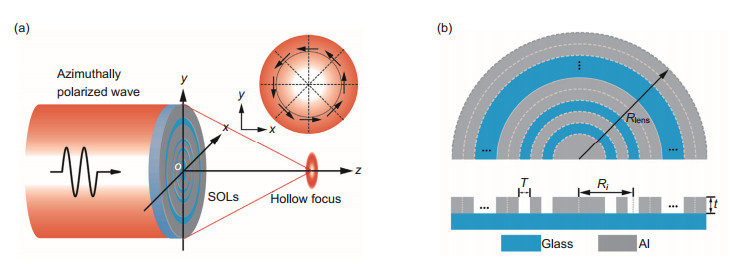
 下载:
下载:
